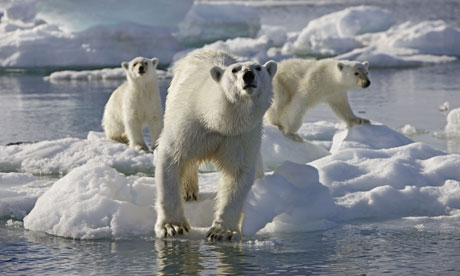
When times are tough, publishers turn to TV tie-ins. This year three major series, two from the BBC and one from Channel 4, have produced blockbusters for the Christmas market.
Inside Nature's Giants by David Dugan and Richard Dawkins (HarperCollins, £19.99), and Planet Dinosaur by Cavan Scott and Darren Naish (BBC Books, £19.99) are for anyone who likes their nature big and fierce, and both bring a new slant to familiar subjects. Frozen Planet by Alastair Fothergill, Vanessa Berlowitz and David Attenborough (BBC Books, £24.99) reveals the extraordinary life found in the polar regions. The most memorable images from the series are recaptured, with a well-written text, emphasising the fragility of these extraordinary places.
Photography gets its annual showcase in two volumes featuring award-winning pictures. Wildlife Photographer of the Year edited by Rosamund Kidman Cox (Natural History Museum, £24.99) has reached its 21st birthday, and achieves the usual high standard. British Wildlife Photography Awards edited by Paul Mitchell and Donna Wood (AA, £24.99) is only in its second year, but is already a worthy rival to its elder sibling.
Art books might be expected to struggle in the current climate, yet our need to escape from political and economic turmoil keeps them selling. Langford Press has once again delivered quality, with There and Back: A Celebration of Bird Migration edited by Andy Brown and Michael Warren (£50), a timely collection of essays and artwork on the threats facing the world's migratory birds. Even more original is Wildlife In Printmaking, edited by Carry Akroyd (£38), a beautifully produced volume featuring the work of more than 20 artists.
Another attractive book comes from artist Rachel Lockwood, whose North Norfolk: A Painted Landscape (Red Hare, £25) features evocative landscapes from her adopted county. Her bold use of colour reinvents these familiar places with striking originality.
Writers on nature have been busy too. Three authoritative volumes hail from the Collins New Naturalist series: Plant Pests by David V Alford; Plant Galls by Margaret Redfern; and Marches by Andrew Allott (all £50); and there is also a large-format new edition of the bestselling Collins Bird Guide (£50). To the delight of New Naturalist fans, Collins has reissued the 22 monographs, originally published from 1948 to 1971, on a print-on-demand basis. These include some of the finest accounts of individual species ever written: Ernest Neal's The Badger, John Buxton's The Redstart and Denis Summers-Smith's The House Sparrow (all £50).
Both novice and experienced birders will welcome another reissue. Teach Yourself Bird Sounds by Dominic Couzens and John Wyatt (2 CD set, CJ Wildlife, £14.95) is an excellent step-by-step guide to the songs and calls of garden and woodland birds.
I enjoyed The Urban Birder by David Lindo (New Holland, £9.99), an honest account of growing up as the only black, working-class birder in Britain; and Life with Birds, an erudite yet readable voyage around the relationship between birds and people, by former Guardian writer Malcolm Smith (Whittles Publishing, £18.99). From the same publisher comes the intriguing Big Cats: Facing Britain's Wild Predators by Rick Minter (£18.99). This weaves a fascinating story around British sightings of these fearsome predators – large feral cats resembling panthers, pumas and lynx. Fierce creatures are also featured in Ianthe Ruthven's quirky and original Animal London: A Spotter's Guide (Square Peg, £9.99). She doesn't photograph the capital's foxes and peregrines, but instead seeks out gargoyles, statues and carvings of animals – real and mythological – around London's streets.
My final three choices are produced for the more specialised naturalist, yet should also appeal to anyone passionate about wildlife. The Royal Entomological Society Book of British Insects by Peter C Barnard (Wiley-Blackwell, £39.95) is the first work to feature all 558 of Britain's insect families – not just bees, butterflies and beetles, but a host of other fascinating creatures.
Larger animals feature in The Handbook of the Mammals of the World: volume 2, Hoofed Mammals, edited by Don E Wilson and Russell A Mittermeier (Lynx Edicions, £139.99). This covers more than 400 species in 17 families, including aardvarks and antelopes, hippos and horses, elephants, rhinoceroses and deer; all in astonishing detail, and illustrated with striking photographs.
But for my book of the year, there could only be one contender: the final volume in the sister series to The Handbook of the Mammals, The Handbook of the Birds of the World. Edited by Josep del Hoyo, Andrew Elliot and David A Christie, Volume 16: Tanagers to New World Blackbirds (Lynx Edicions, £185) brings this epic series to a close – though there are ambitious plans to keep it updated via the internet. Twenty years ago, when this project featuring every one of the world's 10,000 or so bird species began, many people doubted that it could ever be completed. To have done so, and to such consistently high standards, is a towering achievement. The publishers deserve the highest praise for showcasing the world's birds at a time when they need our help more than ever before.
• Stephen Moss's Wild Hares and Hummingbirds: The Natural History of an English Village is published by Square Peg.
• Which natural history books would you give this year?

